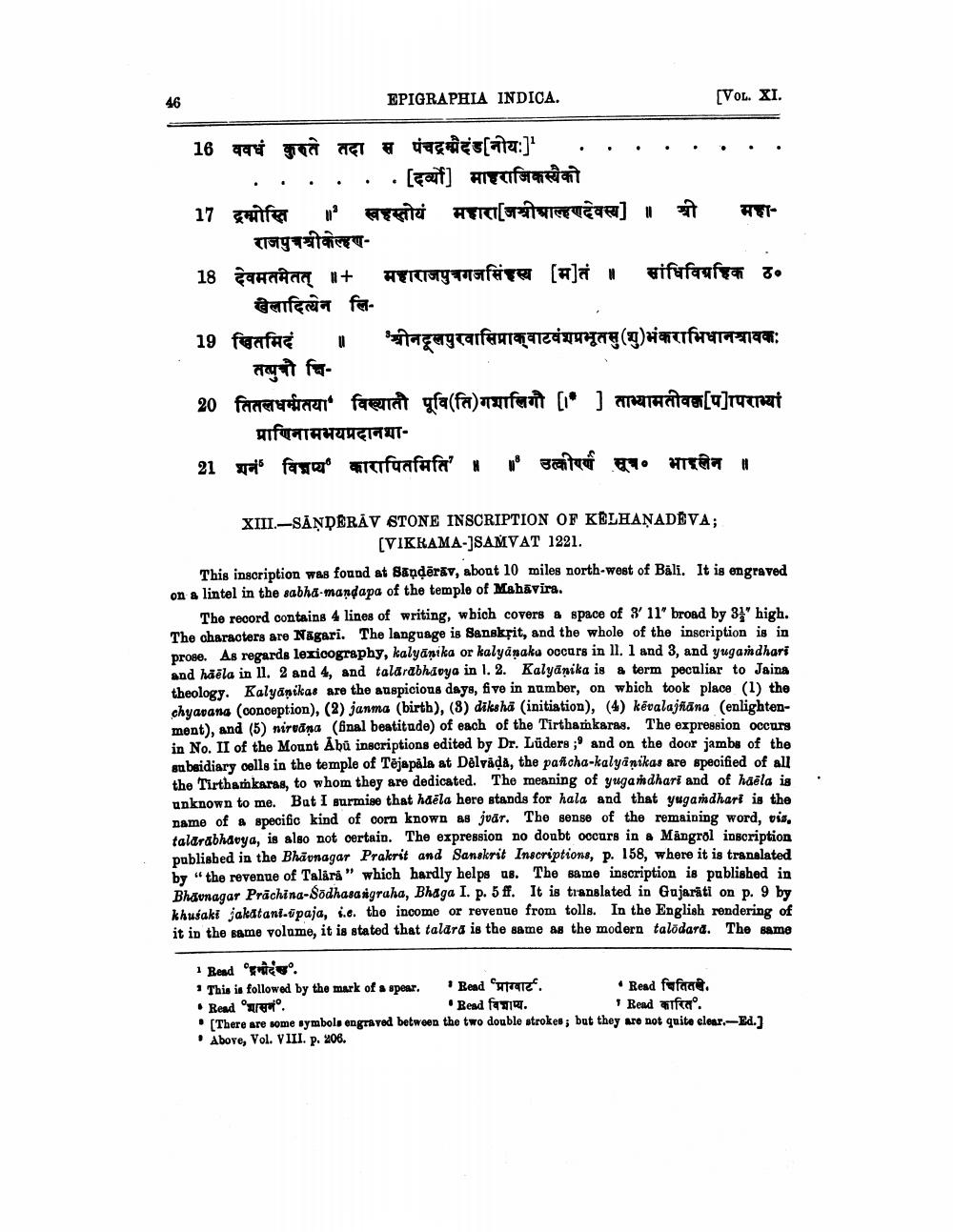________________
EPIGRAPHIA INDICA.
[VoL. XI.
16 ववधं कुरुते तदा स पंचद्रम्मेदंडनीयः] . . . . . . . .
. . . . . . [द?] माहराजिकस्यैको 17 द्रम्मोस्ति ।' स्वहस्तोयं महारा[जश्रीपाल्हणदेवस्य] ॥ श्री महा
राजपुत्रीकल्हण18 देवमतमेतत् ॥+ महाराजपुत्रगजसिंहस्य [म]तं ॥ सांधिविग्रहिक ठ.
खेलादित्येन लि19 खितमिदं । 'श्रीनदूलपुरवासिप्राक्वाटवंशप्रभूतसु(यु)भंकराभिधानश्रावकः
तपुची चि20 तितलधर्मतया' विख्यातो पूवि(ति)गशालिगौ [ ] ताभ्यामतीवक[प]पिराभ्यां
प्राणिनामभयप्रदानथा21 शन विज्ञप्य' कारापितमिति' । । उत्कीर्ण सूत्र० भाइलेन ।
XIII.-SĀNDERAV STONE INSCRIPTION OF KELHAŅADEVA;
[VIKRAMA-]SAMVAT 1221. This inscription was found at Bapdérav, about 10 miles north-west of Bali. It is engraved on a lintel in the sabha-mandapa of the temple of Mahavira.
The record contains 4 lines of writing, which covers & space of 3' 11" broad by 31" high. The characters are Nagari. The language is Sansksit, and the whole of the inscription is in prose. As regards lexicography, kalyanika or kalyanaka occurs in ll.land 3, and yugaindhari and haēla in 11. 2 and 4, and talarabhaoya in 1. 2. Kalyānika is a term peculiar to Jaina theology. Kalyānikas are the auspicious days, five in number, on which took place (1) the chyavana (conception), (2).janma (birth), (8) diksha (initiation), (4) kévalajitana (enlightenment), and (5) niredna (inal beatitude) of each of the Tirthankaras. The expression occurs in No. II of the Mount Abü inscriptions edited by Dr. Lüders ;' and on the door jambs of the subsidiary oells in the temple of Tēja pala at Délvāda, the pafcha-kalyanikas are specified of all the Tirthamkaras, to whom they are dedicated. The meaning of yugandhari and of haēla is unknown to me. Bat I surmise that haēla here stands for hala and that yugandhart is the name of a specific kind of corn known asjvar. The sense of the remaining word, vis, talarabhavya, is also not oertain. The expression no doubt occurs in a Mangrol inscription published in the Bhavnagar Prakrit and Sanskrit Inscriptions, p. 158, where it is translated by the revenue of Talara" which hardly helps us. The same inscription is published in Bhavnagar Prachina-Södhasangraha, Bhaga I. p. 5 ff. It is translated in Gujarati on p. 9 by khubaki jakatani-paja, i.e. the income or revenue from tolls. In the English rendering of it in the same volume, it is stated that talara is the same as the modern talodard. The same
1 Rend 'भीर्दछ * This is followed by the mark of a spear. Read more.
• Read चितितली. • Read शासन.
Resd विचाप्य.
- Read कारित. . (There are some symbols engraved between the two double strokes; but they are not quite clear.-Ed.) . Above, Vol. VIII. p. 206.




